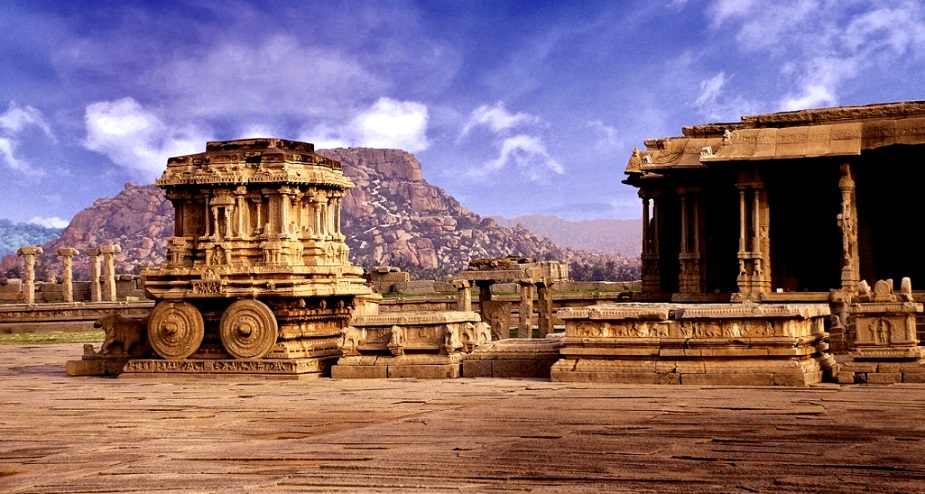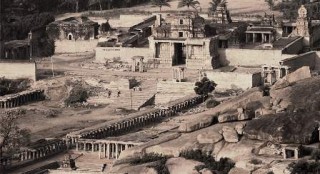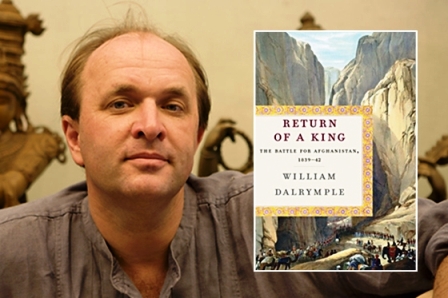In several articles and speeches since at least 2004 (“Trapped in the ruins”, The Guardian, 20 March 2004), and especially in the commotion provoked by Girish Karnad’s speech in Mumbai (autumn 2012), William Dalrymple has condemned Nobel prize winner V.S. Naipaul for writing that the Vijayanagar empire was a Hindu bastion besieged by Muslim states.
The famous writer has taken the ruins of vast Vijayanagar as illustration of how Hinduism is a “wounded civilization”, viz. wounded by Islam. Dalrymple’s counter-arguments against this conflictual view of Indian history consist in bits of Islamic influence in the Vijayanagar kings’ court life, such as Hindu courtiers wearing Muslim dress, Hindu armies adopting techniques borrowed from the Muslims, styles of palace architecture and the Persian nomenclature of political functions; and conversely, elements of Hinduism in Muslims courts and households, e.g. the Muslim festival of Muharram looking like the Kumbha Mela of the Hindus.
Secularism and Vijayanagar
As is all too common in Nehruvian-secularist discourse, Dalrymple’s analysis of the role of Islam in India stands out by its superficiality. Whenever a Hindu temple or a Muslim festival is found to employ personnel belonging to the opposite religion, secular journalists go gaga and report on this victory of syncretism over religious orthodoxy. Secular historians including Dalrymple do likewise about religious cross-pollination in the past.
It is true that Hindus are eager to integrate foreign elements from their surroundings, from Hellenistic astrology (now mis-termed “Vedic astrology”) in the past to the English language and American consumerism today. So Hindu courts adopted styles and terminology from their Muslim counterparts. They even enlisted Muslim mercenaries in their armies, so “secular” were they.
We could say that Hindus are multicultural at heart, or open-minded. But that quality didn’t get rewarded, except with a betrayal by their Muslim regiments during the battle of Talikota (1565): they defected to the enemy, in which they recognized fellow-Muslims. When the chips were down, Hindu open-mindedness and syncretism were powerless against their heartfelt belief in Islamic solidarity. In September 2012, Dalrymple went to Hyderabad to praise the city and its erstwhile Muslim dynasty as a centre of Hindu-Muslim syncretism; but fact is that after Partition, the ruler of Hyderabad opted for Pakistan, against multicultural India. When the chips are down, secular superficiality is no match for hard-headed orthodoxy.
Muslims too sometimes adopted Hindu elements. However, it would be unhistorical to assume a symmetry with what the Hindus did. Hindus really adopted foreign elements, but most Muslims largely just retained Hindu elements which had always been part of their culture and which lingered on after conversion. Thus, the Pakistanis held it against the Bengalis in their artificial Muslim state (1947-71) that their language was very Sanskritic, not using the Arabic script, and that their womenfolk “still” wore saris and no veils. The Bengali Muslims did this not because they had “adopted” elements from Hinduism, but because they had retained many elements from the Hindu culture of their forefathers. “Pakistan” means the “land of the pure”, i.e. those who have overcome the taints of Paganism, the very syncretism which Dalrymple celebrates. Maybe it is in the fitness of things that a historian should sing paeans to this religious syncretism for, as far as Islam is concerned, it is a thing of the past.

Hampi
A second difference between Hindus and Muslims practicing syncretism is that in the case of Muslims, this practice was in spite of their religion, due to a hasty (and therefore incomplete) conversion under duress and a lack of sufficient policing by proper Islamic authorities. If, as claimed by Dalrymple, a Sultan of Bijapur venerated both goddess Saraswati and prophet Mohammed, it only proves that he hadn’t interiorized Mohammed’s strictures against idolatry yet. In more recent times, though, this condition has largely been remedied. Secular journalists now have to search hard for cases of Muslims caught doing Hindu things, for such Muslims become rare. Modern methods of education and social control have wiped out most traces of Hinduism. Thus, since their independence, the Bengali Muslims have made great strides in de-hinduizing themselves, as by widely adopting proper Islamic dress codes. The Tabligh (“propaganda”) movement as well as informal efforts by clerics everywhere have gone a long way to “islamize the Muslims”, i.e. to destroy all remnants of Hinduism still lingering among them.
Hindu Iconoclasm?
Another unhistorical item in the secular view of Islam in India is the total absence of an Islamic prehistory outside India. Yet, all Muslims know about this history to some extent and base their laws and actions upon it. In particular, they know about Mohammed’s career in Arabia and seek to replicate it, from wearing “the beard of the Prophet” to emulating his campaigns against Paganism.
Dalrymple, like all Nehruvians, makes much of the work of the American Marxist historian Richard Eaton. This man is famous for saying that the Muslims have indeed destroyed many Hindu temples (thousands, according to his very incomplete list, though grouped as the oft-quoted “eighty”), but that they based themselves for this conduct on Hindu precedent. Indeed, he has found a handful of cases of Hindu conquerors “looting” temples belonging to the defeated kings, typically abducting the main idol to install it in their own capital.
This implies a very superficial equating between stealing an idol (but leaving the worship of the god concerned intact, and even continuing it in another temple) and destroying temples as a way of humiliating and ultimately destroying their religion itself. But we already said that secularists are superficial. However, he forgets to tell his readers that he has found no case at all of a Muslim temple-destroyer citing these alleged Hindu precedents. If they try to justify their conduct, it is by citing Mohammed’s Arab precedents. The most famous case is the Kaaba in Mecca, where the Prophet and his nephew Ali destroyed 360 idols with their own hands. What the Muslims did to Vijayanagar was only an imitation of what the Prophet had done so many times in Arabia, only on a much larger scale.
From historians like Eaton and Dalrymple, we expect a more international view of history than what they offer in their account of Islamic destructions in India. They try to confine their explanations to one country, whereas Islam is globalist par excellence. By contrast, Naipaul does reckon with international cultural processes, in particular the impact of Islam among the converted peoples, not only in South but also in West and Southeast Asia. He observes that they have been estranged from themselves, alienated from their roots, and therefore suffering from a neurosis.
So, Naipaul is right and Dalrymple wrong in their respective assessments of the role of Islam in India. Yet, in one respect, Naipaul is indeed mistaken. In his books Among the Believers and Beyond Belief, he analyses the impact of Islam among the non-Arab converts, but assumes that for Arabs, Islam is more natural. True, the Arabs did not have to adopt a foreign language for religious purposes, they did not have to sacrifice their own national traditions in name-giving; but otherwise they too had to adopt a religion that wasn’t theirs. The Arabs were Pagans who worshipped many gods and tolerated many religions (Jews, Zoroastrians, various Christian Churches) in their midst. Mohammed made it his life’s work to destroy their multicultural society and replace it with a homogeneous Islamic one. Not exactly the syncretism which Dalrymple waxes so eloquent about.
Colonial “Orientalism?”
Did Muslims “contribute” to Indian culture, as Dalrymple claims? Here too, we should distinguish between what Islam enjoins and what people who happen to be Muslims do. Thus, he says that Muslims contributed to Indian music. I am quite illiterate on art history, but I’ll take his word for it. However, if they did, they did it is spite of Islam, and not because of it. Mohammed closed his ears not to hear the music, and orthodox rulers like Aurangzeb and Ayatollah Khomeini issued measures against it. Likewise, the Moghul school of painting shows that human beings are inexorably fond of visual art, but does not disprove that Islam frowns on it.
Also, while some tourists fall for the Taj Mahal, which Naipaul so dislikes, the Indo-Saracenic architecture extant does not nullify the destruction of many more beautiful buildings which could have attracted far more tourists. In what sense is it a “contribution” anyway? Rather than filling a void, it is at best a replacement of existing Hindu architecture with new Muslim architecture. Similarly, if no Muslim music (or rather, music by Muslims) had entered India, then native Hindu music would have flourished more, and who is Dalrymple to say that Hindu music is inferior?
Another discursive strategy of the secularists, applied here by Dalrymple, is to blame the colonial view of history. Naipaul is said to be inspired by colonial Orientalists and to merely repeat their findings. This plays on the strong anti-Westernism among Indians. But it is factually incorrect: Naipaul cites earlier sources (e.g. Dalrymple omits Ibn Battuta, the Moroccan traveler who only described witnessed Sultanate cruelty to the Hindus with his own eyes) as well as the findings of contemporaneous archaeologists. Moreover, even the colonial historians only repeat what older native sources tell them. The destruction of Vijayanagar is a historical fact and an event that took place with no colonizers around. Unless you mean the Muslim rulers.
Negationism
In the West, we are familiar with the phenomenon of Holocaust negationism. While most people firmly disbelieve the negationists, some will at least appreciate their character: they are making a lot of financial, social and professional sacrifices for their beliefs. The ostracism they suffer is fierce. Even those who are skeptical of their position agree that negationists at least have the courage of their conviction.
In India, and increasingly also in the West and in international institutions, we are faced with a similar phenomenon, viz. Jihad negationism. This is the denial of aggression and atrocities motivated by Islam. Among the differences, we note those in social position of the deniers and those in the contents of the denial. Jihad deniers are not marginals who have sacrificed a career to their convictions, on the contrary; they serve their careers greatly by uttering the politically palatable “truth”. In India, any zero can become a celebrity overnight by publishing a condemnation of the “communalists” and taking a stand for Jihad denial and history distortion. The universities are full of them, while people who stand by genuine history are kept out. Like Jawaharlal Nehru, most of these negationists hold forth on the higher humbug (as historian Paul Johnson observed) and declare themselves “secular”.
Whereas the Holocaust lasted only four years and took place in war circumstances and largely in secret (historians are still troubled over the absence of an order by Adolf Hitler for the Holocaust, a fact which gives a handle to the deniers), Jihad started during the life of Mohammed and continues till today, entirely openly, proudly testified by the perpetrators themselves. From the biography and the biographical collections of the Prophet (Sira, Ahadith) through medieval chronicles and travel diaries down to the farewell letters or videos left by hundreds of suicide terrorists today, there are literally thousands of sources by Muslims attesting that Islam made them do it. But whereas I take Muslims seriously and believe them at their word when they explain their motivation, some people overrule this manifold testimony and decide that the Muslims concerned meant something else.
The most favoured explanation is that British colonialism and now American imperialism inflicted poverty on them and this made them do it, though they clothed it in Islamic discourse. You see, the billionaire Osama bin Laden, whose family has a long-standing friendship with the Bush family, was so poor that he saw no option but to hijack some airplanes and fly them into the World Trade Center. What else was he to do? And Mohammed, way back in the 7th century, already the ruler of Medina and much of the Arabian peninsula, just had to have his critics murdered or, as soon as he could afford it, formally executed. He had to take hostages and permit his men to rape them; nay, he just had to force the Jewish woman Rayhana into concubinage after murdering her relatives. If you don’t like what he did, blame Britain and America. Their colonialism and imperialism made him do it! Under the colonial dispensation which didn’t exist yet, he Muslim troops who were paid by the Vijayanagar emperor had no other option but to betray their employer and side with his opponents who, just by coincidence, happened to be Muslim as well. And if you don’t believe this, the secularists will come up with another story.
Conclusion
India is experiencing a regime of history denial. In this sense, the West is more and more becoming like India. There are some old professors of Islam or religion (and I know a few) who hold the historical view, viz. that Mohammed (if he existed at all) was mentally afflicted, that Islam consists of a manifold folie à deux (“madness with two”, where a wife supports and increasingly shares her husband’s self-delusion), and that it always was a political religion which spread by destroying other religions. But among the younger professors, it is hard to find any who are so forthright. There is a demand for reassurance about Islam, and universities only recruit personnel who provide that.
Indeed, many teach false history in good faith, thinking that untruth about the past in this case is defensible because it fosters better interreligious relations in the present. Some even believe their own stories, just like the layman who is meant to lap them up. Such is also my impression of William Dalrymple.



Jishnu
The west produces dishonest rogues as a norm and honest scholars as an exception. That is the reason mainstream narratives are rooted in deception, lies, half-lies, ideology and aimed at maligning the world’s most civilized and tolerant society.
jadumandir
Mr. Elst again excels in his dissection of a subject. Never mind that oaf Dalrymple, he does not belong to India, but we have our own home-made negationists as mentioned by Mr Elst in places like JNU and in the extreme left-wing community!
Broad Wit
Dalrymple is an over simplifying buffoon historian! He is a disgrace! There are others like, notably Audrey Trsuchke who has dedicated her life to make Aurangzeb the kindest ruler who ever walked the earth. IMHO VS Naipaul is closer to truth while dissecting how Indians have never recovered from their wounded psyche! This also explains a cunning tyro Italian woman who could subjugate a Congress party of seemingly bright Indians & use it to further the Church’s agenda of purging Hinduism from India!
Manjula
The classical music of India is entirely Hindu. The south Indian classical music is very scientific and is said to be based on Sama Veda. North Indian classical music, while incorporating Islamic influences is decidedly based on the same principles – like the swara, tala/laya concepts and raga system. Violin is said to be adapted from Western classical music and Sitar is said to have been borrowed from Persia. The style of music, however, remains decidedly Indian.
At different times many big names in Hindustani classical field converted to Islam for various reasons. That might explain the so called Islamic ‘influence’.
विजयनगर साम्राज्य की महानता को नकारने का प्रयास क्यों ? Negationism of Vijay Nagar Empire | Patriots Forum
[…] http://indiafacts.co.in/negationism-of-vijayanagar-history/ […]
Nilesh
Look at how much flack the famous atheist Dr Richard Dawkins has got (form the left-liberals of the west) for stating facts about Islam, Islamists and their agenda. It was fine till he criticized Christianity, but when he starts talking about Islam, he is called racist! Now, Islam is not even a culture, let alone being a race. Yet, the propaganda goes on. They introduce terms like Islamophobia to segregate such people. What they don’t want is credible people to speak out truths which are covered up. The intellectual class has got it all wrong in most places in the world and more so in India.